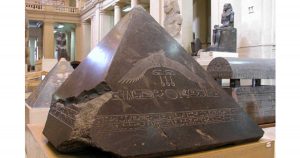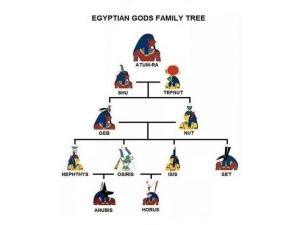Heliopolitan view:
Atum was considered as the supreme deity of Heliopolitan view of ancient Egyptian religious system where the main focus was on the emergence and the development of the cult of Sun god Atum itself. Here he is considered as the self-engendered god of ‘Ennade’, the nine most important gods and goddesses of ancient Egypt in the cosmology according to Heliopolitan view.

What was Atum God of
According to this Heliopolitan view, Atum aroused at the beginning of time. Then he created the first gods and goddesses. There are two different versions of the story of how he created the other deities.

In one version, he is believed to create the first deities through his semen whereas the other version says that it was his saliva through which the first deities were created. There were several names to address Atum such as Tem, Temu, Tum, Atem etc.
Atum Original Creation
It was believed that Atum not only created the first gods but also was the original creation itself. He was believed to be born from primordial waters of creation as a primaeval mound. This special aspect of Atum was reflected symbolically in the form of ‘ben-ben’ stone. During the period of earlier dynasties, This stone was worshipped as the symbol that represented Atum.

Two Aspects Creation and Destruction
It is really interesting to see that in Pyramid texts Atum was described as a creator as well as a destructor. This aspect actually reflects his supremacy over the power of creation that is only he can create everything. According to Heliopolitan mythology, when the world will come to an end, Atum will destroy everything he has created and will return to the form of the primaeval serpent.
Relationship with Pharaohs
It is very interesting to see that in Heliopolitan view, Atum was considered not only as the father of deities but also the genealogical father of all kings or pharaohs of Egypt. Ancient Egyptian pyramid texts have quotations that indicate clearly that the father-son relationship between Atum and pharaohs were considered as a noble relationship.
Atum Lord of Totality
In ancient Egyptian pyramid texts, Atum is called the ‘Lord of Totality’. In this aspect, it was believed that every existed thing was nothing but the part of his flesh because he is the reason behind the totality of everything.
Thus he was believed to be the universal and supreme deity. According to ancient Egyptian coffin texts, the pharaohs got the chance to be united with the supreme god Atum.
Connection with Underworld
God Atum was also connected with the concept of the underworld. According to coffin texts, Atum set in the evening as the aged form of the sun and travelled through the underworld. In this aspect, he is seen in connection with funerary images.
The funerary association of Atum can clearly be shown on the funerary images of royal tombs of the New Kingdom in the valley of Kings. Here Atum is shown as the supervisor of the processes of punishment of evil spirits and enemies of the sun god.
Atum Family Tree
Atum had two children, Tefnut; goddess of moisture and Shu; god of air. These two deities were considered as the first divine couple. Thus Atum was considered the ‘father of the gods.’ These twin deities gave birth Geb; god of earth and Nut; goddess of the sky.
Gradually Geb and Nut gave birth to four children. They were Osiris, Isis, Nephthys and Seth. It is really interesting to see that incest was acceptable among the ancient Egyptian deities in order to continue the legacy of blood.

Iconography of Atum
Atum is generally depicted in anthropomorphic form wearing the ‘Peshent’ crown and seated on the throne or in sitting posture. Sometimes he is also depicted in a combining form of human and animal with the head of a ram; where he basically represents his association with the sun as well as the underworld. He is also depicted in serpent form which represents his primaeval nature.
Pshent Crown
There were different types of crowns for different deities in ancient Egypt. God Atum is depicted with a crown that was known as the Pshent crown. It is a combination crown of white and red colour crowns. This Pshent crown actually represents unified Egypt.

The Osird
The ‘Osird’ or ‘the divine beard’ was basically a false beard that Atum wears. This beard was tightly knotted, plaited and hooked behind the ears. This divine beard basically shows the status of living gods and goddesses.
Thus osrid was used as a divine symbol in various important ceremonies and religious functions. When pharaohs died, they were depicted wearing osrid which actually reflect their status of living gods after their death.
Who was Atum-Ra
The connection between Atum and Ra or Re is very interesting. Both belonged to the solar origin. While these two deities are represented separately, Ra is represented as the rising sun and Atum is represented as the setting sun.

Pyramid texts and coffin texts often give a clear picture of a deity who can be identified with an assimilated form of both the deities; that is ‘Atum-Ra’. Ra emerged in later times and by the period during Fifth Dynasty in 25-24th centuries BCE came in importance and eclipsed Atum to some extent.